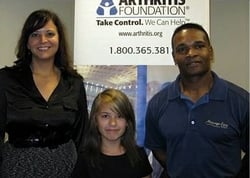Almost 300,000 children in the U.S. suffer from juvenile arthritis. Emily Mogel, 10, has been living with systemic juvenile rheutamoid arthritis since she was two years old. Photograph courtesy of Cindy Mogel
Toddlers will say, “Mommy, I’m sick,” so often that Cindy Mogel brushed it off when her two-year-old daughter, Emily, came to her with the same complaint.
“My mom didn’t believe me at first, because I looked perfectly fine,” Emily recalls. Yet three days later, not only did Emily have a high fever and a salmon-colored rash, but she had also lost all movement in her body.
For weeks, Emily and her parents, who live in Frederick, endured several doctor consultations and tests, waiting for a diagnosis. “It was truly scary,” Cindy says. “For a six-week period, we didn’t know anything.”
Leukemia was a possibility, but bone marrow aspiration results came out negative. Finally, doctors diagnosed Emily with systemic juvenile rheumatoid arthritis (JRA), one of the rarest forms of the disease, characterized by joint swelling, fever, and pain.
Systemic JRA affects the entire body, which is why Mogel, now 10, lost all movement during her first episode as a toddler. Approximately 10 percent of children suffering from JRA have this form of the disease, which can can lead to inflammation of the spleen or of the membranes that cover the lungs and heart. While certain types of JRA are more common in females, both boys and girls are equally vulnerable to systemic JRA.
After her diagnosis, Emily began a whirlwind of medical treatments. At first, she tried anti-inflammatories, but that wasn’t sufficient. She went on steroids—still not enough. Doctors added Methotrexate, a chemotherapy drug, to the growing list. But things didn’t start looking up until Emily started taking weekly injections of a biologic, a genetically engineered protein. With all four medications, her symptoms began to subside, and doctors said she was in remission from the disease.

Emily continued to take all four medicines until she was seven years old, when she went into remission. Gradually weaned off treatments, she was able to lead a relatively normal childhood, playing soccer and taking dance classes. Cindy and Ryan, Emily’s father, were hopeful that it would be the one and only instance of juvenile arthritis to affect their daughter, as the disease can be short-term for children.
Emily wasn’t so lucky. One year later, her parents experienced déjà vu when the eight-year-old again began complaining of feeling sick. She came to them with her wrists held out and said, “Mom and Dad, my wrists really hurt me.”
This time, they knew to take their daughter seriously. “That was a huge indicator to us that the disease came back, because it greatly affected her wrists before,” Cindy says.
Emily’s symptoms returned stronger than before, causing her to miss much of the second grade. “It was just too painful to go to school,” she says, admitting that at times it felt like she was living in a 90-year-old’s body. “It wasn’t just the fevers and the rashes that wouldn’t go away—the pain was unbearable.”
Like many children who suffer from juvenile arthritis, Emily experienced flu-like symptoms and felt zapped of any energy, in addition to the physical pain. She’d spend days on the couch, too weak to even lift an arm. “She certainly wasn’t able to cope and learn in a school environment until treatment was more successful,” Cindy says.
When Emily finally did return to school, her appearance elicited uncomfortable surprise from her classmates. For one, she had gained almost 40 pounds from the steroids. She was also using a wheelchair. “That shocked people, because they didn’t know what had happened to me,” Emily says. “I had been gone for so long.”
These days, she is on a new medication, Actemra, which the Food and Drug Administration approved in March for children older than two who are suffering from systemic juvenile idiopathic arthritis. While she’s still prone to flare-ups, she is grateful for the new treatment, which allows her to occasionally participate in gym class and play with her friends during recess. As a plus, she’s been active enough to have lost all the weight gained from the steroids.
The Mogels continue to learn as much as they can about the chronic illness that has become a part of their daily lives. In July, Emily, her parents, and her older brother and sister attended the Juvenile Arthritis Conference in DC. It turned out to be a great experience for Emily, since she was able to meet other kids who shared her experiences living with arthritis.
Emily and her family are working to raise awareness in Congress about “what people, especially kids, with arthritis go through,” Cindy says. “Our biggest message is that Emily’s trial medication was very successful, and only became available to her because of research.”
“I want kids my age to know that I have a disease that affects my joints, and it’s very, very painful,” Emily says. “It’s not just an adult disease.”
To learn more about juvenile arthritis, visit arthritis.org.
In honor of World Arthritis Day, participating Massage Envy locations will be offering massages and facials at a discounted rate. For each one-hour service, $10 of the cost will be donated to the Arthritis Foundation.



















